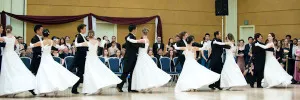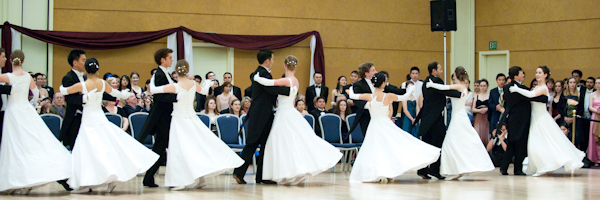Billowing floor-length gowns, sharp tuxedos, a classical waltz played by a live orchestra and couples turning in graceful unison in a classical ballroom–the scene could have jumped straight from the pages of “Pride and Prejudice,” from a time when gentlemen asked to be added to a lady’s “programme du bal” and romance blossomed on polished dance floors. For the participants in the 35th Viennese Ball held last Friday, social dance is still very much a part of modern life.

Held every year during winter quarter, the Viennese Ball is a formal event for which attendees dress up and participate in dances including waltz, swing, cha cha, salsa, tango and polka. Two separate ballrooms, one for classical waltz and the other for tango and salsa, cater to different dance styles and musical tastes, and attendees can move between the rooms throughout the night.
Stanford’s tradition of holding an annual Viennese Ball first began in 1978, when students returning from the Stanford in Austria program organized the event in order to bring Viennese culture and social dance to campus. Since then, despite the closure of the overseas study program, the annual ball has become a Stanford tradition. An event that draws students, alumni and social dance enthusiasts from all over the Bay Area, this year the organizers expected 500 to 700 attendees.
The planning process for the event usually begins the June of the previous year, with new committee members recruited at the start of fall quarter. The “Am Abend” committee–a German term meaning “the night of”–is responsible for organizing the logistics of the event itself, while the opening committee plans and performs the ball’s opening dance, consisting of 18 couples performing a carefully choreographed Viennese waltz. The dancer’s white gowns and tuxedos pay homage to the event’s European origins.
“The opening ceremonies have remained unchanged for some time,” said Rosalind Boone ’10, one of the co-chairs of the “Am Abend” committee. “The dress, even the number of couples in the opening has remained remarkably constant over the years.”
While the Ball is open to all students, some basic dance knowledge is necessary for participation. As a remedy to the Stanford population’s general unfamiliarity with formal dance steps, the Austria Fortnight was born. During the two weeks leading up to the event, the organizing committee holds a series of free dance workshops on campus, introducing novices to the basic skills of social dance.
To overcome what the organizers believe to be a major deterrent to student attendance–personal doubts about dance inexperience–the Ball initiated the Gold Ribbon Program this year. Experienced dancers can volunteer to wear gold ribbons around their wrist on the night of the event, offering to lead and instruct less experienced dancers. The program hopes to encourage new dancers to attend the event.
“The great thing about the dance community here is that even though I’ve never taken a class, I’ve learned a lot through people who are willing to teach,” said Lauren Sweet ’15, who attended the Ball for the first time this year.
The association of “formal ball” with “romance” seems to hold true in the case of the Viennese Ball.
“Every year we have at least five to six couples on the opening committee, most of whom met through dancing,” said M.J. Ma ’12, one of two head chairs.
While couples may enjoy the romantic aspect of the Viennese Ball, it presents another major deterrent for Stanford students: the idea that a partner is necessary in order to attend. The organizers hope to change this perception by encouraging people to switch dance companions while at the Ball.
“People have a misconception that you need a date to go to the dance,” Ma said. “In fact, while at the Ball you can dance with people you’ve never met before, and more often than not you’ll end up connecting through dancing.”
Richard Powers ’70, dance instructor and historian, said he feels that Stanford community members, in contrast to many ballroom dancers, appreciate social dance as a form of social interaction, not as a rigid set of regulations.
“Social dancing is primarily for the fun and pleasure of your partner, and if what you’re doing isn’t fun for yourself and your partner, you’re missing the point,” Powers said. “Stanford students understand that.”
More casual opportunities to perfect one’s waltz and swing are available. In addition to the social dance classes offered by Powers, many other social dance events are held regularly on campus. Jammix, a campus-wide dance event that includes all forms of social dance, is held on the second Friday of every month, while Monday night “Dancebreak” and “Friday Night Waltz” also provide students with opportunities to brush up on their two-step or tango.
Perhaps social events like the Viennese Ball really are relics of an older age, contrasting greatly with the fast pace of most dances on campus today, but organizers, attendees and alumni all believe the Ball offers a certain uniqueness.
“It’s a very dramatic departure from anything else you’ll do at Stanford,” Boone said. “There are other events, and there’s the class formal, but none of them have the same otherworldliness.”
